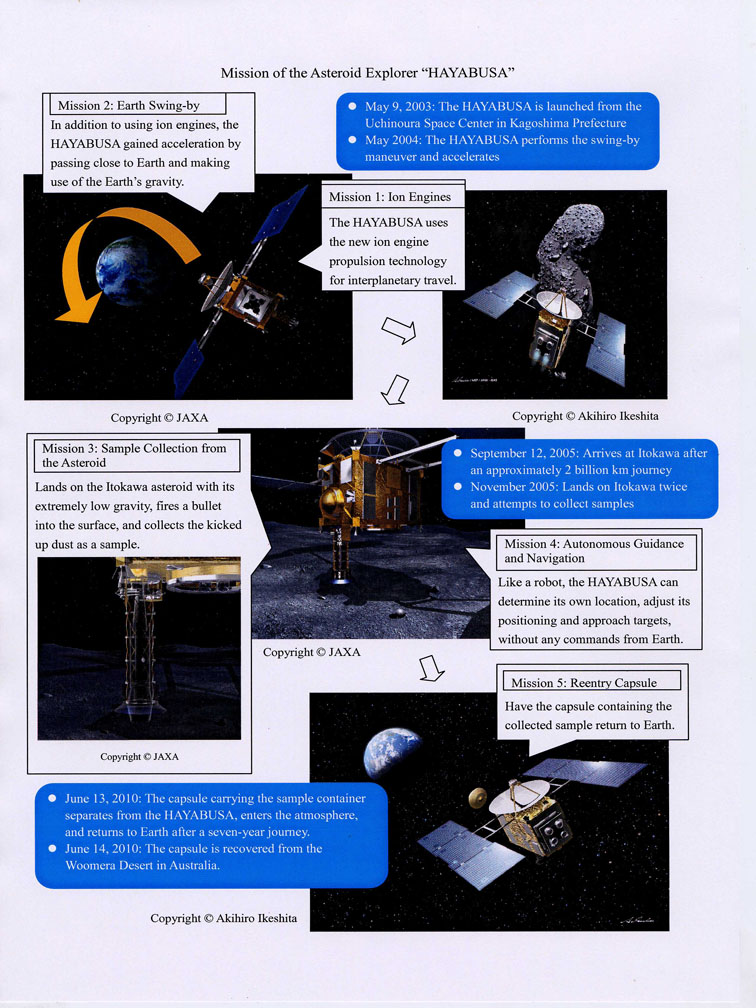Earth Return of the HAYABUSA
The asteroid explorer HAYABUSA (Falcon)*1 returned to Earth on June 13, 2010 following a seven-year, approximately six billion kilometer round-trip journey to the asteroid Itokawa. The HAYABUSA is the first spacecraft to land on a celestial body other than the Moon and then return to Earth.
- The HAYABUSA makes history
- With the exception of lunar probes, to date asteroid probes have only taken one-way trips and remained permanently at their destinations or floating in space. However, round-trip flight is essential for next-generation exploration.
- The HAYABUSA was launched in May 2003 and reached the asteroid Itokawa – approximately 300 million kilometers from Earth – in 2005. The HAYABUSA made history as the first spacecraft to land and return from a celestial body other than the Moon. It also achieved the longest spaceflight in history at 2,592 days.
- The HAYABUSA capsule, which may contain a sample from Itokawa, was successfully recovered from the Woomera Desert in Australia. If the capsule does contain a sample, it will be the first sample from an asteroid brought back to Earth and may provide precious clues about the origin and evolution of the Solar System.
2. Many Japanese space technologies supported the HAYABUSA
The HAYABUSA encountered numerous problems on its return trip from Itokawa including loss of control, loss of communications, and a breakdown of its main engines. While the planned four-year flight took seven years, superior Japanese space technologies made it possible for the HAYABUSA to overcome these difficulties and safely return to Earth.
- Ion Engines – a New Technology
The HAYABUSA used ion engines developed and produced by NEC under the direction of the Japanese Aerospace Exploration Agency (JAXA) for its distant flight and return to Earth. The ion engines use sunlight as an energy source. Although their thrust is inferior compared with that from conventional chemical fuel engines, the ion engines provide efficient propulsion using little fuel, and are suitable for long-range space travel. The HAYABUSA operated for a total of 40,000 hours – a world record for a single space probe.
- Autonomous Guidance and Navigation System
The HAYABUSA used an autonomous guidance and navigation system employing laser altimeters, close-range sensors and other devices to determine its own location, adjust its positioning and approach targets. The HAYABUSA collected the data and made its own determinations for its approach and landing on Itokawa.
- Touchdown on Itokawa and Sample Collection
As Itokawa is a very low-gravity asteroid, the HAYABUSA carried a special sample collection mechanism developed to break up the ground following touchdown on Itokawa by striking the surface with a metal bullet to kick up dust for sample collection.
- Reentry Capsule
This is a 40cm-diameter capsule carrying the sample container from Itokawa. Special materials were used for the capsule to withstand its reentry to the Earth’s atmosphere at a speed of more than 12 km per second. After being slowed by the atmosphere, the capsule opened its parachute and made a soft landing on Earth
NOTES
*1. The name Hayabusa (Falcon) was chosen because the “touch and go” sample collection method whereby the HAYABUSA was to land just briefly on Itokawa for sample collection resembles how falcons capture their prey.
*2. See http://hayabusa.jaxa.jp/e/index.html for more detailed explanations concerning the HAYABUSA.
 |